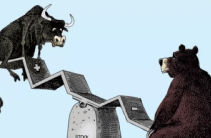Fra Advisorsperspectives:
The conventional wisdom is that U.S. stocks are overvalued and the only uncertainty is the timing of the inevitable correction. But Robert Shiller says his CAPE ratio, when considered alongside low bond yields, is not giving “much of a sell signal” for U.S. stocks.
But he said that equity investors should not be surprised by a market downturn.
Shiller is a professor of finance at Yale University. He spoke via a conference call hosted by Barclay’s Investors for its RIA clients.
He is also the author of the recently published book, Narrative Economics: How Stories Go Viral and Drive Major Economic Events. Much of his talk was oriented to the theme of how certain narratives take hold in the public discourse and become the drivers of economic events.
There are too many uncertainties to forecast as normal, according to Shiller, which may be why he placed so much emphasis on narratives. The “big depression” scenario is a narrative that is frequently discussed, he said, as it was 10 years ago during the great financial crisis. He is not forecasting that outcome, but said it is possible.
The U.S. took 10 years to recover from the Great Depression, and that is the common narrative that informs people’s thinking. The lesson we draw from it is based on the image of people standing in bread lines and jumping suicidality from tall buildings, he said.
Forecasting should be based on observations from the popular narratives, according to Shiller. Since Trump was elected, the dominant narrative was that the U.S. was the country of strong growth, but that narrative has evaporated and been replaced by depression-like scenarios.
The damage to the economy is long-lasting, he said, and it is a question of how long the depression narrative will “spook people.”
Enochlophobia, which is a fear of crowds, might build up. It may not go away once the epidemic subsides. As a medical condition, it is related to agoraphobia, an anxiety disorder that can make people afraid to leave their houses. Psychologists acknowledge that narratives feed those phobias, he said.
In addition, we are confronting an “affect heuristic,” a mental shortcut that is used to make automatic decisions and is based on current emotions. For many people today, fear of the virus is leading to fear of everything, which prolongs fears among those who are so predisposed.
We won’t get over the fear of the virus quickly, Shiller said. “It could mutate and keep coming back, and be around for 100 years.” That is not a forecast, he said, “just a scenario.”
Other narratives are spreading wishful thinking and a positive scenario, such as the belief that we are close to finding a cure with remdesivir, or that a vaccine could be quickly developed. If one of those did happen, say in a year, Shiller said a strong recovery is possible. That would push the stock market to new highs.
Without that, Shiller expects coming weakness in the market. Business models will be outdated and earnings will suffer, he said. “It’s hard to do anything without getting together with others.”
“We don’t know if the pandemic will disappear,” he said, “and mere uncertainty could bring the market down.”
“I don’t want to be too alarming,” he said. “Some investors could be rewarded.”
As for the potential for monetary policy to bolster the economy, he said our knowledge of it is based on less dramatic events. The Fed has done about as much as it can, Shiller said. It has created new facilities, similar to old ones, and taken quick action that has supported the market.
As for negative rates, Shiller said there still is a zero lower bound. The narrative that matters is Japan and its huge market decline starting in 1989, followed by negative rates and its “lost decades.” Negative rates sounds desperate and don’t inspire, he said, which is why the Fed has pursued other policies.
Modern monetary theory is misnamed, he said. It is really Keynesian economics – the belief that incurring a debt is appropriate when the economy needs stimulus. He said he supports that policy direction, but does not think it is new.
“The problem is that we’ve gone pretty far with monetary and fiscal policy,” Shiller said.
But he said we need to spend more on testing and contact tracing. We should spend more on managing the virus, even if it “crosses the law.” He did not elaborate on that comment, but presumably he meant that contact tracing should be aggressive and potentially compromise privacy concerns.
This time in history may be an opportunity to identify which firms will do better in the aftermath of the crisis, according to Shiller. The same is true with universities, which are confronted with whether traditional campus life will return in the fall. He said he doesn’t know whether bigger companies or those that are more nimble or those with a more loyal customer base will thrive.
Big-cap technology stocks have been favored by the market, because of a narrative that people want to be part of the technology revolution. Technology such as Zoom is reinforcing the value of technology. But he said he is not sure whether their valuations are accurate.
As for the key question of market valuations, he said that low bond yields, especially low real yields, are supporting stock prices despite a weak economy.
The U.S. CAPE ratio is 27, which is not as high as in 2000, when it was 45. But it is about as high as it was in 1929 and 2007. But we also have the lowest bond yields in history, he said. “It’s not clear, between the stock and bond trade off, which one dominates.”
Those who have tried to time the market have been wrong, and Shiller cited data to bolster that claim. In 2009, his surveys of investors showed that the perceived probability of a crash was very likely at the bottom of the market. Those survey respondents were wrong. At the beginning and the end of 2018, there were stock market corrections. Both times there was a V-shaped recovery that investors overall did not predict. Even now, the market peaked on February 19, well after the coronavirus was evident.
“Valuations are fed more by imagination and wishful thinking than normal,” Shiller said.
President Trump feeds this wishful narrative, he said. Even those who don’t like him are buying stocks. There is a patriotic spirit supporting prices, Shiller said.



